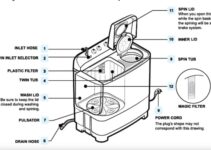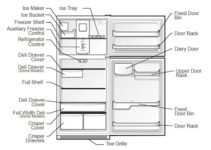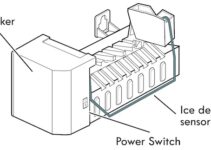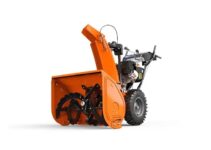Whether you’re trying to fix your appliance or simply looking for replacement parts for your LG WT1101CW, this blog is for you. Here we have put together a parts diagram with all the information you could need to get your machine up and running again.
A top-loading washing machine exudes a lovely sense of comfort and familiarity. The design is uncomplicated, the drum is simple to clean, and any stain can be treated directly on top of it. Convenience features like these should be prioritized while purchasing expensive home appliances.
Here, we’d be looking at the LG WT1101CW parts diagram showing the machine’s components. We’d also explain what each component does and how it works.
LG WT1101CW Parts Diagram

LG WT1101CW Parts Explained(as Seen on the Diagram)
1. Water pump
Because it is housed within the machine itself, the water pump is not actually visible to the user. The pump is responsible for both emptying the water once the cycle is finished as well as recirculating the water while it is operating during the cycle. It’s possible that certain machines have two separate pumps: one that only moves water, and another that moves waste. This will change depending on the model of the washer.
2. Washer Drain Hose
This hose is just one of the numerous essential washing machine elements that are essential to the machine’s ability to function in a sanitary manner, and it is one of those essential parts. During the washing cycle, as well as after it has finished, the drain hose, if it has been placed correctly, will guide wastewater away from the washing machine and into the septic or sewer system.
3. Water inlet control valves
Located close to the place where the water enters the harbor. These valves are open and closed in response to the weight of the load and the quantity of water that must be dispensed to complete a wash cycle.
4. Tub/Drum
The washer that you have actually has two tubs inside of it. The first one is a mobile tub with holes punched into it, and this is where the clothing goes. The perforated surface makes it possible for water to enter and exit the system at various points throughout the cycle. During the washing cycle, the outer tub serves both as a support for the inner tub and as a reservoir for water.
5. Agitator/Impeller/Lifter
It is dependent on the model of your washing machine as to whether or not it has an agitator or an impeller. They will always be found on the interior of the washing machine’s inner tub, regardless of the model you have, and they are a crucial component in the process of getting your clothing clean. Their movements cause the garments to move about and rub against each other, which in turn helps to remove dirt and stains from the fabric.
6. Washing machine motor
The action that enables your washing machine’s agitator, discs, or drum to revolve is powered by the machine’s motor while the machine is going through its various cycles.
7. Printed circuit board
The printed circuit board, sometimes known as a PCB, is the electronic component that controls the washing machine. It is responsible for controlling the control panel and wash cycles and activating the various electronic components required for your washer to perform its function. In addition, the PCB is in charge of determining how much water is in the machine, how much detergent is discharged, and any other tasks that your washer may have.
8. Timer
Timers on washing machines can be set manually or automatically, and they will determine the amount of time spent washing each cycle of your laundry. It’s possible that your washing machine doesn’t have a timer because this feature isn’t standard on all models.
9. Control panel
This panel, which can be found either on the top or the front of the washing machine, will serve as the point of control for all of the settings and wash cycles.
10. Heating element
This component is responsible for bringing the water up to the desired temperature during the use of cycles that will run either warm or hot water. Note: Heating elements are model dependent.
Other Parts of the LG WT1101CW
Drain Pump
Before beginning the spin cycle, the drain function of a washing machine is responsible for emptying the tub of any water that may have accumulated there. The drain hose of the washing machine is attached to the pump, which sucks water up from the bottom of the machine and into the drain hose. Because the drain line for the washing machine winds its way around the top of the machine and then back down to the drain, the tub can fill up with water.
Wash plate cap
The cap for the wash plate is designed to fit over the mounting bolt for the wash plate so that it can shield the bolt and keep garments from becoming caught on the wash plate.
Washer Leveling Leg
This leveling leg, which consists of a lock nut and a pad, is utilized in order to maintain stability and equilibrium in washing machines. If your washing machine is very shaky and moves around a lot, then this could be a simple and speedy remedy to the problem you’re having with it.
Washer Base
To reduce wobbly, uneven, and vibrating washers, the washer base can be positioned towards the bottom of the washer. This enhances drainage while also keeping the machine steady. Without foundation, the washer’s bottom rests directly on the drain, leaving little clearance for effective drainage. The foundation raises the appliance above the drain, enhancing water drainage efficiency. A platform not only improves drainage but also makes it much simpler to install the machine. There is no need to worry about uneven floors while installing units.





